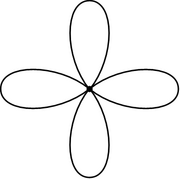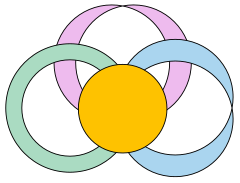
In mathematics, a bouquet graph , for an integer parameter , is an undirected graph with one vertex and edges, all of which are self-loops. It is the graph-theoretic analogue of the topological bouquet, a space of circles joined at a point. When the context of graph theory is clear, it can be called more simply a bouquet.[1]

Although bouquets have a very simple structure as graphs, they are of some importance in topological graph theory because their graph embeddings can still be non-trivial. In particular, every cellularly embedded graph can be reduced to an embedded bouquet by a partial duality applied to the edges of any spanning tree of the graph,[2] or alternatively by contracting the edges of any spanning tree.
In graph-theoretic approaches to group theory, every Cayley–Serre graph (a variant of Cayley graphs with doubled edges) can be represented as the covering graph of a bouquet.[3]
References
- ^ Beineke, Lowell W.; Wilson, Robin J. (2009), Topics in topological graph theory, Encyclopedia of Mathematics and its Applications, vol. 128, Cambridge University Press, Cambridge, p. 5, doi:10.1017/CBO9781139087223, ISBN 978-0-521-80230-7, MR 2581536
- ^ Ellis-Monaghan, Joanna A.; Moffatt, Iain (2012), "Twisted duality for embedded graphs", Transactions of the American Mathematical Society, 364 (3): 1529–1569, arXiv:0906.5557, doi:10.1090/S0002-9947-2011-05529-7, MR 2869185
- ^ Sunada, Toshikazu (2013), Topological Crystallography: With a View Towards Discrete Geometric Analysis, Surveys and Tutorials in the Applied Mathematical Sciences, vol. 6, Springer, Tokyo, p. 69, doi:10.1007/978-4-431-54177-6, ISBN 978-4-431-54176-9, MR 3014418




